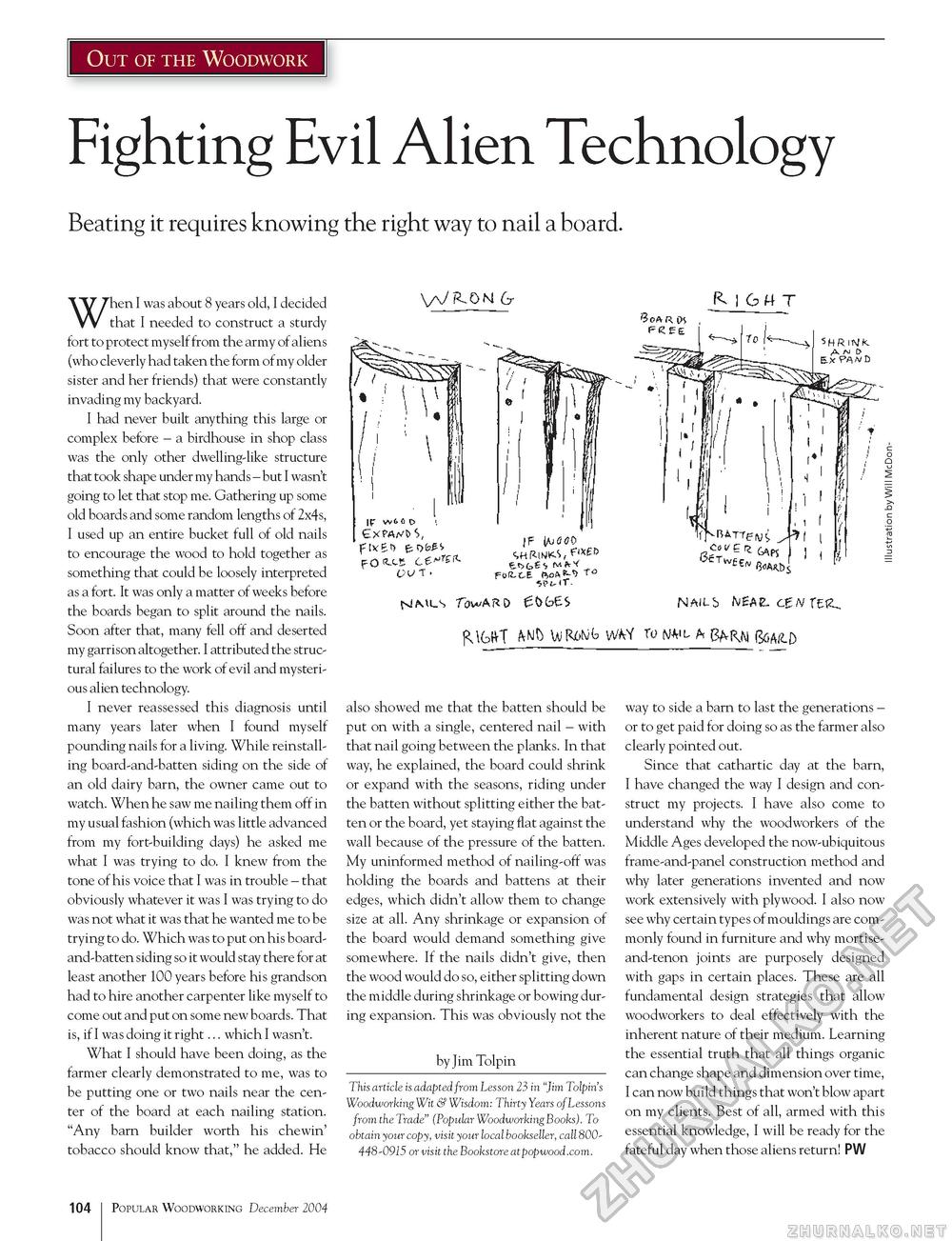Popular Woodworking 2004-12 № 145, страница 99
Out of the Woodwork Fighting Evil Alien Technology Beating it requires knowing the right way to nail a board. W^OM (y wfc G '. £XPA/>/t> S, flv&fi fcDfefi OV T ■ K 16(41 free SHRiNfc AN D JF l*j£J<?0 J-jmls Toward £C>bes RATTeivi <3<>AK.t>s
NftlLb fyg^E. Cg/VfEt^ f^tfcfVT \Nb\AlRWuk WW To NAIL A BARN When I was about 8 years old, I decided that I needed to construct a sturdy fort to protect myself from the army of aliens (who cleverly had taken the form of my older sister and her friends) that were constantly invading my backyard. I had never built anything this large or complex before - a birdhouse in shop class was the only other dwelling-like structure that took shape under my hands - but I wasn't going to let that stop me. Gathering up some old boards and some random lengths of 2x4s, I used up an entire bucket full of old nails to encourage the wood to hold together as something that could be loosely interpreted as a fort. It was only a matter of weeks before the boards began to split around the nails. Soon after that, many fell off and deserted my garrison altogether. I attributed the structural failures to the work of evil and mysterious alien technology. I never reassessed this diagnosis until many years later when I found myself pounding nails for a living. While reinstalling board-and-batten siding on the side of an old dairy barn, the owner came out to watch. When he saw me nailing them off in my usual fashion (which was little advanced from my fort-building days) he asked me what I was trying to do. I knew from the tone of his voice that I was in trouble - that obviously whatever it was I was trying to do was not what it was that he wanted me to be trying to do. Which was to put on his board-and-batten siding so it would stay there for at least another 100 years before his grandson had to hire another carpenter like myself to come out and put on some new boards. That is, if I was doing it right ... which I wasn't. What I should have been doing, as the farmer clearly demonstrated to me, was to be putting one or two nails near the center of the board at each nailing station. "Any barn builder worth his chewin' tobacco should know that," he added. He also showed me that the batten should be put on with a single, centered nail - with that nail going between the planks. In that way, he explained, the board could shrink or expand with the seasons, riding under the batten without splitting either the batten or the board, yet staying flat against the wall because of the pressure of the batten. My uninformed method of nailing-off was holding the boards and battens at their edges, which didn't allow them to change size at all. Any shrinkage or expansion of the board would demand something give somewhere. If the nails didn't give, then the wood would do so, either splitting down the middle during shrinkage or bowing during expansion. This was obviously not the by Jim Tolpin This article is adapted from Lesson 23 in "Jim Tolpin's Woodworking Wit & Wisdom: Thirty Years of Lessons from the Trade" (Popular Woodworking Books). To obtain your copy, visit your local bookseller, call 800448-0915 or visit the Bookstore atpopwood.com. way to side a barn to last the generations -or to get paid for doing so as the farmer also clearly pointed out. Since that cathartic day at the barn, I have changed the way I design and construct my projects. I have also come to understand why the woodworkers of the Middle Ages developed the now-ubiquitous frame-and-panel construction method and why later generations invented and now work extensively with plywood. I also now see why certain types of mouldings are commonly found in furniture and why mortise-and-tenon joints are purposely designed with gaps in certain places. These are all fundamental design strategies that allow woodworkers to deal effectively with the inherent nature of their medium. Learning the essential truth that all things organic can change shape and dimension over time, I can now build things that won't blow apart on my clients. Best of all, armed with this essential knowledge, I will be ready for the fateful day when those aliens return! PW 100 Popular Woodworking December 2004 |







